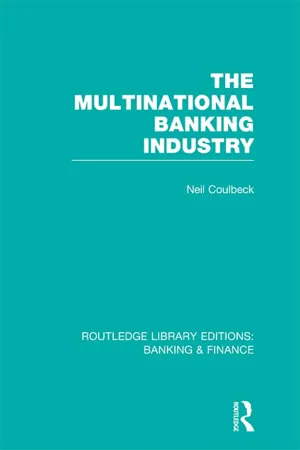![]()
1 MULTINATIONAL BANKING
1.1 Banks and Their Services
Types of Bank
The classification of financial institutions presents some analytical problems since we can use various criteria. Vittas and others in their seminal study of comparative banking (1978) use as their main criterion the function of the bank or financial institution and propose the following scheme:
- Central bank.
- Deposit–taking institutions.
- Medium– and long–term credit institutions.
- Investing institutions.
Within this scheme they classify organisations further according to the system used by the official statistics of the individual countries. These statistical classifications may have been based either on further functional specialisation, on size, on locality, on type of ownership, on statutory or regulatory provisions.
Certainly function is the most useful general criterion. Central banks are public bodies which in all countries maintain control, by various mechanisms, of the national currency in both domestic and international markets. They also usually have overall responsibility for the banking system and the provision of bank credit. Deposit– taking institutions are empowered to accept deposits from the general public, and they will usually employ these deposits in short– and medium–term lending. They may operate in retail and business sectors, and in domestic, international and retail markets, and the larger deposit–taking institutions may well have developed as commercial enterprises to the extent that they have diversified into numerous other financial services. Since deposit–taking institutions have also progressively extended the volume and maturity of their term lending they have begun to take over many functions of the medium– and long–term credit institutions in many countries. These bodies, many of them created to assist in post-War reconstruction, are often joint ventures of deposit-taking institutions, or are public agencies. They usually borrow by means of notes and debentures from investing institutions and deploy these funds in long–term loans to industry and by taking equity stakes. The investing institutions include insurance companies and pension funds and are not relevant to our discussion of banks, although they do compete in some of the same financial markets.
The present study is primarily concerned with deposit–taking institutions in different countries, and there are numerous subgroups to consider. The deposit–taking institutions include banks and other types of institution, often known as near–banks. The distinction is usually embodied in statute or regulation. Most deposit banks are also clearing banks since they clear cheques for their customers including other non–clearing banks. They are also described as national banks, because of their nationwide coverage, and money–centre or city banks because they operate from head offices in financial centres. They are also often described as commercial banks to distinguish them from merchant or investment banks. Merchant or investment banks do not normally raise deposits from the public and provide a specialised range of services usually geared to the needs of corporate and international customers.
The form of ownership and organisation is another important method of differentiating between types of bank. Most deposit banks are public companies quoted on the stock exchange of their own and sometimes other countries. Some, however, are under public ownership. Some are privately owned, although this is now virtually extinct. Many merchant or investment banks are still privately owned. Then there are public–sector agencies such as departments of the post office, mutual organisations, trusteeships, cooperative organisations, institutions created by special law or charter, and so on. The remarkable fact is that organisations of such different character compete in the same markets and use much the same methods in order to survive and grow.
The precise nature of the large deposit banks is further complicated by the fact that most of them have gone part or all of the way along the road to becoming universal banks, banks which offer all types of service, and this has usually meant the acquisition of large numbers of subsidiaries and affiliated companies and the adoption of a holding company structure. Under this arrangement the original deposit bank then becomes one of many subsidiaries, although usually by far the largest, of a commercial company; or is itself the parent holding company of its diverse subsidiary and associated companies.
In the international markets we come across various specialised types of bank, frequently acting as subsidiaries or affiliates of deposit banks. These include Eurobanks, specialising in Eurocurrency business, basically a type of merchant bank, and consortium banks which are joint ventures of larger banks acting in concert. The term international bank is usually very loosely used to refer to banks which participate in international banking markets.
It can be seen that a large universal bank can in fact be described by a variety of names, as is shown in the example of German universal banks.
Public limited companies (Aktiengesellschaft, AG) quoted on German and other stock exchanges.
Group structure (bank plus subsidiaries and affiliates*).
Bank (Kreditwesengesetz, Banking Act 1961).
Clearing banks.
Deposit banks (public deposits and savings).
National banks (branch networks).
Commercial banks (short–term deposits and lending).
Merchant/investment banks (no division of functions in German system).
Mortgage bank subsidiaries.
International banks.
Eurobank subsidiaries.
Consortium bank participations.
*Note that the bank is the holding company. US banks have a separate holding company of which the bank is a subsidiary.
Bank Services
Banks in all countries meet their customers’ financial needs by supplying a range of services in convenient locations under the management of qualified staff. There are of course differences in the details of the services offered in different countries, and there are significant differences in the extent of the range of services some banks are permitted to offer or wish to offer. Nevertheless, it is possible to describe in general terms the main types of service offered by commercial banks throughout the...
